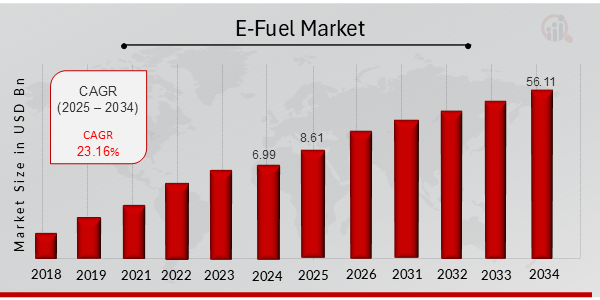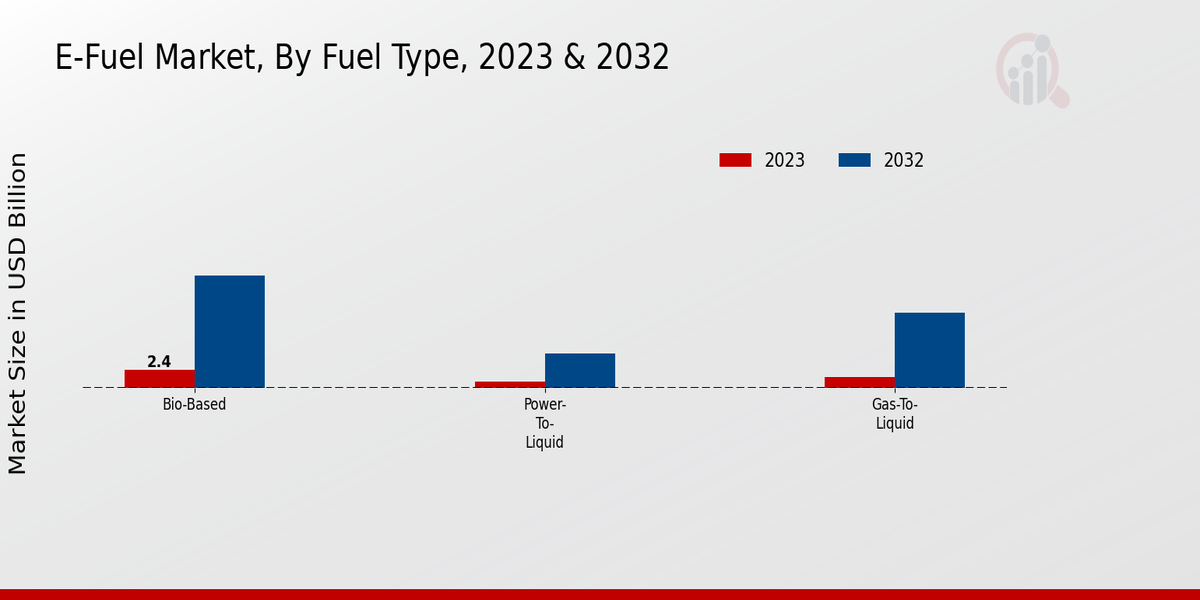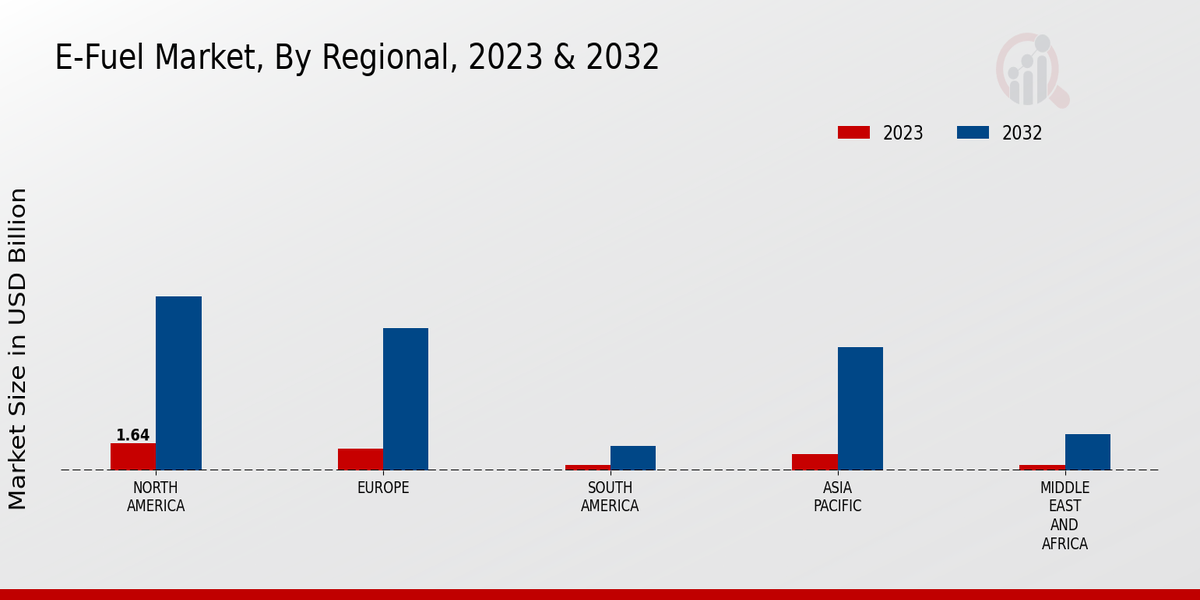Global E-Fuel Market Overview
As per MRFR analysis, the E-Fuel Market Size was estimated at 6.99 (USD Billion) in 2024. The E-Fuel Market Industry is expected to grow from 8.61 (USD Billion) in 2025 to 56.11 (USD Billion) till 2034, at a CAGR (growth rate) is expected to be around 23.16% during the forecast period (2025 - 2034).
Key E-Fuel Market Trends Highlighted
The E-Fuel Market is expected to rise in the next few years owing to the growing concerns regarding the environment, growing demands in favor of eco-friendly transport, and government policies favoring renewable energy usage in various sectors. The primary marketing factors include increased severity of emission cuts, increasing oil prices, and technological advances in the production of e-fuels. Opportunities created mainly include the development of low-cost and scalable e-fuel production technologies, integration of the fuel producers and the automotive industry, and the development of global e-fuel value chains.
New developments in the e-fuel market include the use of renewable feedstocks other than fossil such as waste materials, progress on e-fuel blending with other fuels, and the rise of new market participants. The market is predicted to see a rise in investment in e-fuel-focused research and development, facilities for commercial-scale production of e-fuels, and facilities for e-fuel distribution and usage.

Source Primary Research, Secondary Research, MRFR Database and Analyst Review
E-Fuel Market Drivers
Government Regulations and Policies
The rise of government initiatives across the globe is responsible for the emerging demand for the products within the E-Fuel Market Industry. There has been a growing trend of implementing policies and regulations that allow for greenhouse gas emissions to be reduced while promoting clean and renewable sources of energy. One example is the European Union, which plans to reduce greenhouse gas emissions by 55% until the year 2030 and become climate-neutral by the year 2050.
To achieve such objectives, the EU is promoting the use of e-fuels in a variety of sectors, from transportation to industry as well. Another example is the US Administration, which announced that billions of dollars would be spent on research and development of clean energy, including e-fuels. Overall, government initiatives across the world are expected to drive the growth of the E-Fuel Market Industry in the future.
Increasing Demand for Sustainable Transportation
The transportation sector is one of the main sources of greenhouse gas emissions, and the demand for sustainable transportation is increasing all over the world extremely fast. E-fuels are considered to be one of the evident solutions for decarbonizing the transportation sector because e-fuel is applied in the already existing internal combustion engine, and there is no need to make any considerable and large investments in the technology upgrade.In addition, e-fuels can be produced on the basis of sustainable and renewable sources, such as biomass and waste. The existing and increasing demand for sustainable transportation and relevant technologies will contribute to the industry’s growth in the future.
Technological Advancements and Cost Reductions
Technological advancements are leading to the development of more efficient and cost-effective e-fuels. For instance, researchers are developing new catalysts that can improve the efficiency of e-fuel production. In addition, the cost of e-fuels is expected to decline as the technology matures and economies of scale are achieved. These factors are expected to make e-fuels more competitive with fossil fuels in the coming years.
E-Fuel Market Segment Insights
E-Fuel Market Fuel Type Insights
The E-Fuel Market is segmented based on fuel type into bio-based, power-to-liquid, and gas-to-liquid. The bio-based segment is projected to account for the largest market share during the forecast period, owing to the increasing demand for sustainable and renewable fuels. The power-to-liquid segment is expected to witness significant growth due to the rising adoption of renewable energy sources. The gas-to-liquid segment is anticipated to grow at a steady pace, driven by the increasing demand for cleaner fuels in the transportation sector.
In 2023, the bio-based segment accounted for approximately 40% of the E-Fuel Market revenue. The segment is expected to continue its dominance throughout the forecast period, reaching a valuation of USD 12.0 billion by 2032. The growth of the segment can be attributed to the increasing awareness of environmental sustainability and the adoption of bio-based fuels in various applications, including transportation, power generation, and industrial processes. The power-to-liquid segment is projected to grow at a CAGR of 25.0% during the forecast period, reaching a valuation of USD 9.0 billion by 2032.
The segment's growth is driven by the increasing demand for renewable energy sources and the development of efficient power-to-liquid technologies. Power-to-liquid fuels offer a promising alternative to fossil fuels, as they can be produced using renewable electricity and stored for long periods of time. The gas-to-liquid segment is anticipated to grow at a CAGR of 20.0% during the forecast period, reaching a valuation of USD 7.0 billion by 2032. The segment's growth is driven by the increasing demand for cleaner fuels in the transportation sector. Gas-to-liquid fuels are produced from natural gas and offer several advantages over conventional fossil fuels, including lower emissions and higher energy efficiency.

Source Primary Research, Secondary Research, MRFR Database and Analyst Review
E-Fuel Market Production Process Insights
The market segmentation by Production Process includes Fischer-Tropsch, Methanol-to-Gasoline, and Biomass-to-Liquid. Among these, the Fischer-Tropsch segment held the largest market share in 2023 and is anticipated to maintain its dominance throughout the forecast period. The widespread adoption of Fischer-Tropsch technology in commercial-scale e-fuel production facilities is attributed to its high efficiency and ability to utilize a wide range of feedstocks, including natural gas, coal, and biomass.
Methanol-to-Gasoline technology is projected to experience significant growth due to its cost-effectiveness and the increasing availability of methanol as a byproduct of various industrial processes. Biomass-to-Liquid technology, though still in its early stages of development, offers the potential for sustainable e-fuel production from renewable biomass resources.
E-Fuel Market Application Insights
The application segment of the E-Fuel Market is expected to witness significant growth in the coming years, driven by increasing demand for sustainable and low-carbon fuels. Light-duty vehicles, which include passenger cars and light commercial vehicles, are expected to account for the largest share of the market, with a projected revenue of $12.4 billion by 2024. Heavy-duty vehicles, including trucks and buses, are also expected to contribute significantly to the market, with a projected revenue of $9.8 billion by 2024. The aviation and marine sectors are expected to witness growing demand for e-fuels as airlines and shipping companies seek to reduce their carbon footprint.
E-Fuel Market Carbon Intensity Insights
The Carbon Intensity segment is an essential aspect of the E-Fuel Market analysis. It categorizes e-fuels based on their carbon footprint, offering insights into the industry's sustainability efforts. The segment includes three primary subcategories Low-Carbon, Zero-Carbon, and Carbon-Neutral. Low-Carbon e-fuels are derived from renewable energy sources and have a lower carbon footprint compared to fossil fuels. Their production process involves capturing and utilizing CO2, resulting in reduced greenhouse gas emissions. The E-Fuel Market for Low-Carbon e-fuels is projected to reach $10.5 billion by 2024, exhibiting significant growth potential due to increasing environmental concerns and regulations.
Zero-Carbon e-fuels are produced using renewable energy sources and have a carbon footprint of zero. They do not emit greenhouse gases during production or combustion, making them an environmentally friendly alternative to fossil fuels. The E-Fuel Market for Zero-Carbon e-fuels is anticipated to surpass $15 billion by 2024, driven by the rising demand for sustainable transportation solutions. Carbon-Neutral e-fuels are produced using renewable energy sources and have a carbon footprint that is offset through carbon capture and storage or other carbon mitigation strategies. They aim to achieve a balance between carbon emissions and carbon removal, contributing to the industry's efforts towards sustainability. The E-Fuel Market for Carbon-Neutral e-fuels is estimated to reach $7 billion by 2024, highlighting the growing importance of carbon neutrality in the industry.
E-Fuel Market Technology Provider Insights
The E-Fuel Market segmentation by Technology Provider is dominated by Neste, Haldor Topsoe, Velocys, and Air Liquide. These players have been actively involved in developing and commercializing e-fuel technologies. Neste, for instance, has invested heavily in research and development of renewable diesel production technologies. The company's NEXBTL technology is used to produce e-diesel from renewable feedstocks, such as vegetable oils and waste fats. Haldor Topsoe, another prominent player in the e-fuel market, offers a range of technologies for the production of e-fuels, including methanol, ethanol, and dimethyl ether (DME).
Velocys has developed a proprietary Fischer-Tropsch (FT) technology for the production of synthetic fuels from natural gas and biomass. Air Liquide, a global leader in industrial gases, provides hydrogen and other gases essential for the production of e-fuels. The company has also developed a technology for the production of renewable hydrogen from electrolysis. The increasing demand for sustainable transportation fuels is driving the growth of the e-fuel market. Governments worldwide are implementing policies to promote the adoption of e-fuels, such as tax incentives and blending mandates. Moreover, the rising environmental concerns and the need to reduce greenhouse gas emissions are further fueling the demand for e-fuels.
E-Fuel Market Regional Insights
The E-Fuel Market is segmented into North America, Europe, APAC, South America, and MEA. North America held the largest market share in 2023 and is expected to continue its dominance throughout the forecast period. The region's growth can be attributed to the presence of major automakers and government initiatives to promote the adoption of electric vehicles. In 2023, the E-Fuel Market revenue in North America was valued at 1.5 billion USD and is projected to reach 9.2 billion USD by 2032, exhibiting a CAGR of 25.1%. Europe is the second-largest market for e-fuels.
The region has a strong focus on environmental sustainability and has set ambitious targets for reducing greenhouse gas emissions. This has led to increased investment in e-fuel production and infrastructure. In 2023, the E-Fuel Market revenue in Europe was valued at 1.2 billion USD and is projected to reach 7.5 billion USD by 2032, exhibiting a CAGR of 24.3%. APAC is expected to witness the fastest growth in the E-Fuel Market during the forecast period. The region has a large and rapidly growing automotive industry, with China being the world's largest market for electric vehicles.In 2023, the E-Fuel Market revenue in APAC was valued at 0.9 billion USD and is projected to reach 6.5 billion USD by 2032, exhibiting a CAGR of 27.2%. South America and MEA are relatively small markets for e-fuels but are expected to grow at a steady pace in the coming years. The regions have a growing awareness of the environmental benefits of e-fuels and are investing in production and infrastructure.

Source Primary Research, Secondary Research, MRFR Database and Analyst Review
E-Fuel Market Key Players And Competitive Insights
Major players in the E-Fuel Market are continuously striving for technological advancements and strategic collaborations to gain a competitive edge in the industry. They are investing heavily in research and development to improve the efficiency and cost-effectiveness of E-Fuel production processes. Leading E-Fuel Market players are also focusing on expanding their global reach and establishing partnerships with key stakeholders in the automotive and energy industries. The E-Fuel Market development is being driven by the increasing demand for sustainable and environmentally friendly transportation solutions. Governments across the globe are implementing favorable policies and regulations to promote the adoption of E-Fuels, which is further fueling the growth of the industry. The E-Fuel Market Competitive Landscape is characterized by intense competition among existing players and the entry of new entrants. Companies are adopting various strategies to differentiate themselves in the market, including product innovation, strategic partnerships, and aggressive marketing campaigns.
One of the leading companies in the E-Fuel Market is HIF Global LLC. The company is a pioneer in the development and production of E-Fuels, and it has established partnerships with major players in the automotive and energy industries. HIF Global is currently constructing a large-scale E-Fuel production facility in Chile, which is expected to begin operations in 2023. The company's focus on sustainability and its innovative approach to E-Fuel production make it a strong competitor in the market. Another key player in the E-Fuel Market is Porsche AG.
The company has been actively involved in the development and testing of E-Fuels, and it has announced plans to invest heavily in E-Fuel production. Porsche is collaborating with other leading companies in the industry to establish a global network of E-Fuel production facilities. The company's strong brand recognition and its commitment to sustainability make it a formidable competitor in the market.
Key Companies in the E-Fuel Market Include
- Sunfire
- Carbon Engineering
- Phillips 66
- Neste
- BP
- Valero Energy
- TotalEnergies
- Renewable Energy Group
- World Energy
- Audi
- Aemetis
- Shell
- Marathon Petroleum
- Chevron
- ExxonMobil
E-Fuel Market Industry Developments
The E-Fuel Market is anticipated to witness substantial growth in the coming years. In 2023, the market was valued at approximately USD 4.6 billion and is expected to reach around USD 30.0 billion by 2032, exhibiting a CAGR of 23.16% during the forecast period. This growth is attributed to rising concerns over climate change and increasing demand for sustainable transportation fuels. Governments worldwide are implementing supportive policies and regulations to promote the adoption of E-Fuels, further driving market growth. Key players in the industry are investing in research and development to enhance E-Fuel production and distribution capabilities. Recent news highlights include the announcement of a joint venture between Porsche and Siemens Energy to construct a commercial E-Fuel plant in Chile, expected to commence operations in 2026. Moreover, major automotive manufacturers are partnering with E-Fuel producers to secure supply for their future vehicle models.
E-Fuel Market Segmentation Insights
- E-Fuel Market Fuel Type Outlook
- Bio-based
- Power-to-Liquid
- Gas-to-Liquid
- E-Fuel Market Production Process Outlook
- Fischer-Tropsch
- Methanol-to-Gasoline
- Biomass-to-Liquid
- E-Fuel Market Application Outlook
- Light-Duty Vehicles
- Heavy-Duty Vehicles
- Aviation
- Marine
- E-Fuel Market Carbon Intensity Outlook
- Low-Carbon
- Zero-Carbon
- Carbon-Neutral
- E-Fuel Market Technology Provider Outlook
- Neste
- Haldor Topsoe
- Velocys
- Air Liquide
- E-Fuel Market Regional Outlook
- North America
- Europe
- South America
- Asia Pacific
- Middle East and Africa
| Report Attribute/Metric |
Details |
|
Market Size 2024
|
6.99 (USD Billion)
|
|
Market Size 2025
|
8.61 (USD Billion)
|
|
Market Size 2034
|
56.11 (USD Billion)
|
|
Compound Annual Growth Rate (CAGR)
|
23.16% (2025 - 2034)
|
|
Report Coverage
|
Revenue Forecast, Competitive Landscape, Growth Factors, and Trends
|
|
Base Year
|
2024
|
|
Market Forecast Period
|
2025 - 2034
|
|
Historical Data
|
2019 - 2023
|
| Market Forecast Units |
USD Billion |
| Key Companies Profiled |
Sunfire, Carbon Engineering, Phillips 66, Neste, BP, Valero Energy, TotalEnergies, Renewable Energy Group, World Energy, Audi, Aemetis, Shell, Marathon Petroleum, Chevron, ExxonMobil |
| Segments Covered |
Fuel Type, Production Process, Application, Carbon Intensity, Technology Provider, Regional |
| Key Market Opportunities |
Growing demand for sustainable aviation fuel Government incentives and subsidies Technological advancements in efuel production Expansion into new markets Partnerships and collaborations |
| Key Market Dynamics |
Rising demand for sustainable aviation fuels Government policies supporting low-carbon fuels Technological advancements in efuel production Growing investments in renewable energy sources Increasing adoption in the transportation sector |
| Countries Covered |
North America, Europe, APAC, South America, MEA |
Frequently Asked Questions (FAQ) :
The E-Fuel Market was valued at USD 6.99 billion in 2024 and is expected to reach USD 56.11 billion by 2034, exhibiting a CAGR of 23.16% during the forecast period.
North America and Europe are the dominant markets for E-Fuels, with Asia-Pacific emerging as a promising region due to increasing government support and rising demand for sustainable transportation solutions.
E-Fuels are primarily used in the transportation sector, including aviation, road transport, and marine applications. They offer a sustainable alternative to fossil fuels, reducing greenhouse gas emissions and improving air quality.
Prominent players in the E-Fuel Market include Neste, World Energy, HIF Global, GenFuels, and Lanzatech. These companies are investing in research and development to enhance E-Fuel production technologies and expand their market reach.
The E-Fuel Market faces challenges such as high production costs compared to fossil fuels, limited availability of sustainable feedstocks, and the need for supportive government policies to promote widespread adoption.
Governments worldwide are implementing regulations to encourage the adoption of E-Fuels. These regulations include tax incentives, blending mandates, and emissions standards, which are driving the growth of the E-Fuel Market.

















